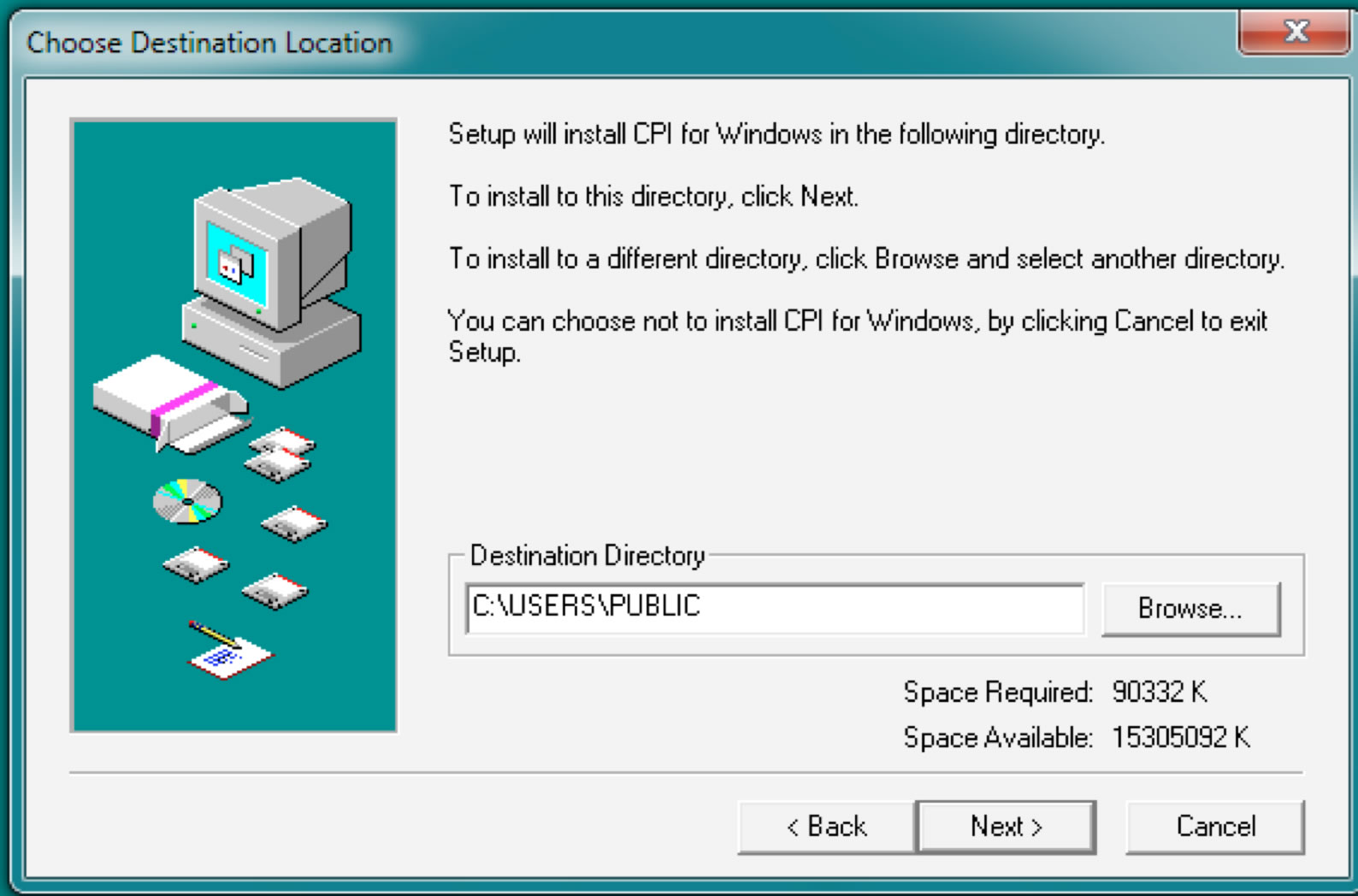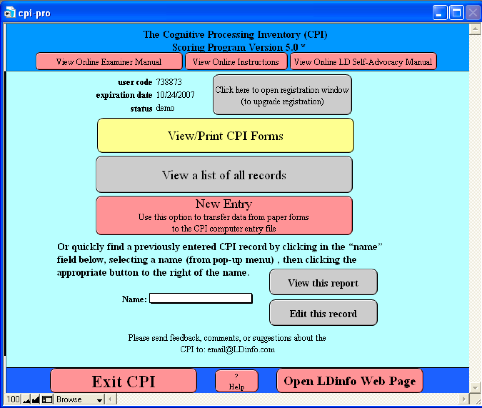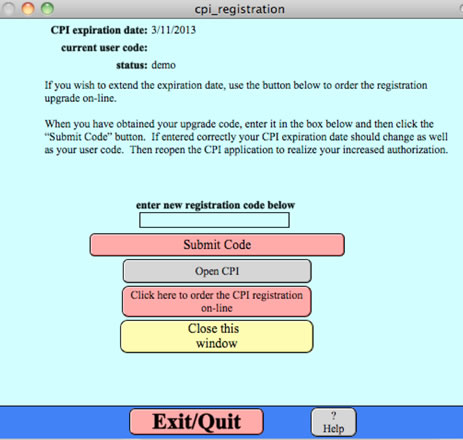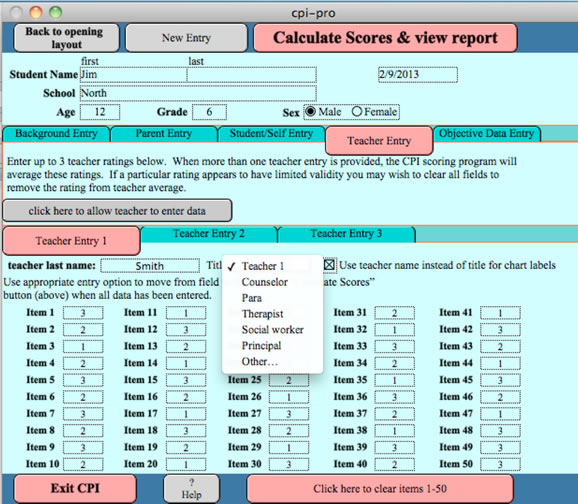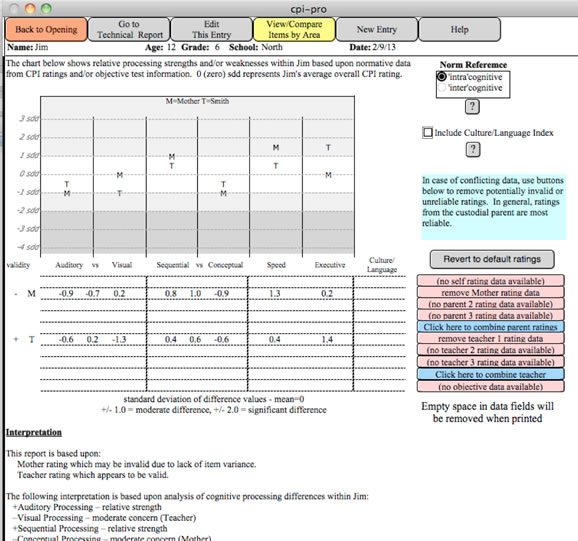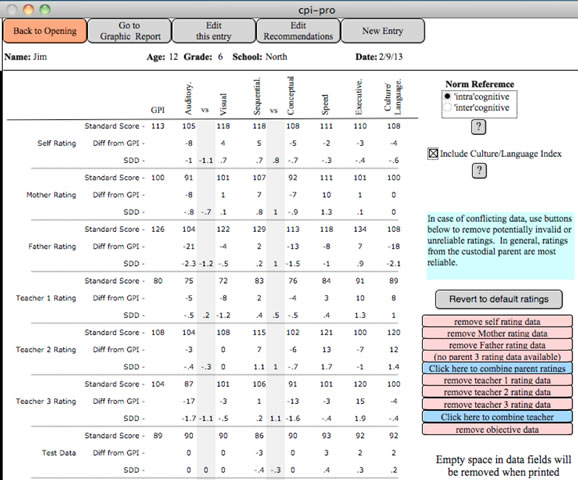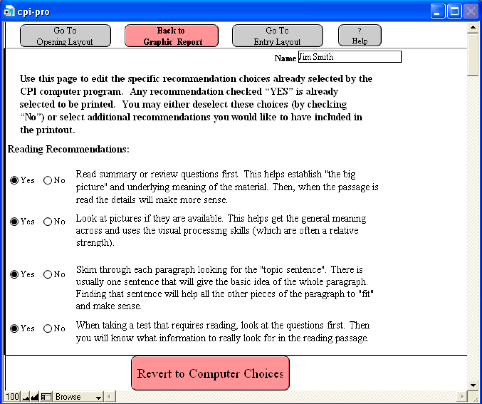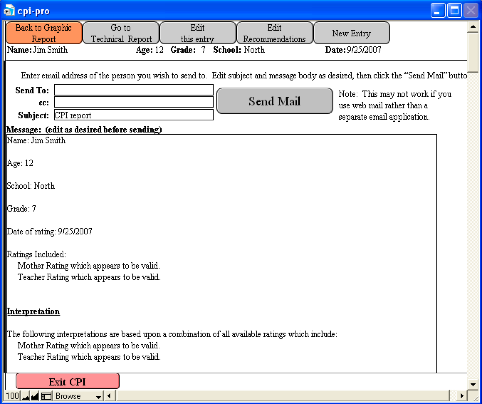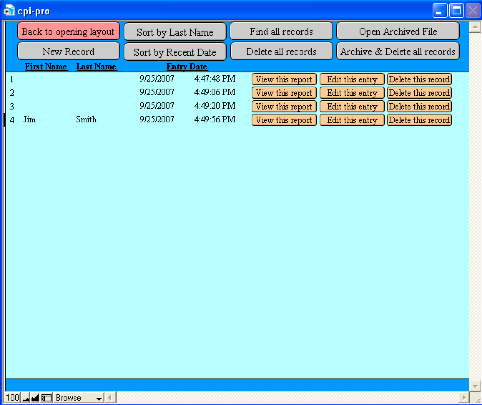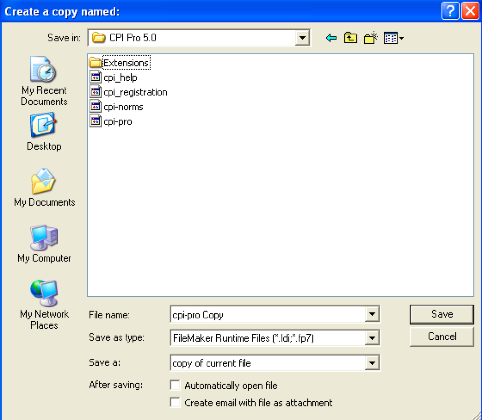Installation and Use of the CPI
Professional Software
Installation:
If the CPI software package was
downloaded from the web site, your web browser probably unstuffed the file and
created the appropriate CPI installer (for Mac or Windows) on your hard drive.
Whether installing from the downloaded installer or from the CD-ROM, simply
open the installer and follow the on-screen instructions.
During installation, by default
the CPI package is placed either in the 'Program Files' directory (Windows) or
in your main hard drive directory (Macintosh) unless you select a different
location.
An 'alias' or 'shortcut' is also
created on your Windows desktop or Macintosh Dock for easy access to the CPI
application.
Important: Always be sure that all
files related to the CPI scoring application remain inside the CPI Pro
folder/directory where they first exist. If these files are moved, the scoring program and/or registration codes
may not function properly.
Using the CPI:
To begin using any of the CPI
materials (scoring file, forms, manual, instructions, etc.) simply double-click
the CPI Pro application or the desktop shortcut (or alias). If you are opening a demonstration
version of the application, you will first be presented a popup message
describing the limitations of that version along with options for upgrading
your registration.
Simply click “OK” in the
“Registration Notice” window in order to proceed to the actual
application.
If you have purchased a
registration code, click the button near the top of the next screen (shown
below) to enter the code and register the software.
This will open a separate
registration window where you can enter your registration code.
After entering a valid
registration code, you will be presented a “Thank You” message. Simply click “OK” on that message and
the software will reopen to complete the registration process.
If you are using a registered version
of the CPI, the application will open directly to the screen which gives
various options including viewing/printing forms, starting a new entry or
viewing a list of existing entries.
If you are wishing to view or edit
an existing entry you can simply select the name of the subject from the
drop-down list and click the appropriate button to the right of the name.
Completing an entry on a new
subject is accomplished in 4 easy steps as follows:
Step 1: From the opening screen
click the button entitled 'View/Print CPI Rating Forms'. A new window will open
in which you can preview and/or print the various paper rating forms. You may
either print 1 copy of each form and then duplicate them as needed or just
print new forms as you need them. In either case, the printed forms will note
the expiration date for you to legally print or duplicate the forms (based upon
your registration status).
Step 2: Distribute CPI rating
forms to parents, teachers, and/or subjects and collect the completed forms for
scoring.
Step 3: To score completed CPI
forms, simply open the CPI Pro application and click the 'New Entry' button.
A new window will open which
allows entry of subject information including name, age, grade, school, etc. Be
sure to enter an age in whole years (no dashes, decimal points, months, etc.)
and sex so that the norm-referenced scores can be accurately calculated.
Then select the appropriate button
below that section to begin entering actual rating data (from parent, teacher,
or self-ratings).
For each parent entry you may
select from a list of parent/guardian types to be used as the label in the
interpretive chart and descriptions.
You may enter multiple ratings for
each subject (i.e. parent, teacher, and/or student/self ratings) in order to
directly compare results on the graphic display provided in the report.
Step 4: When available ratings
have been entered, simply click the 'Calculate Scores/View Report' button at
the top of the window. A new window will open in which you can preview graphic
displays of each rating category, combine or separate parent or teacher ratings
or exclude certain ratings. You may also select the level of significance
required for interpretation as described below.
The default interpretation is
based upon intra-cognitive differences (within the subject) based upon the
significance of such differences found within the norm group. Although this is clearly the most
appropriate interpretive option, in rare cases you may wish to switch to the
alternate inter-cognitive comparison (using the button in the top right corner
of the screen) which will simply base interpretations on differences between
obtained standard scores and the mean of the norm group (100).
To the right of the graphic display and data chart are additional buttons allowing you to combine/separate multiple parent or teacher ratings or exclude specific ratings (possibly due to low validity). Combining/Separating parent or teacher ratings: By default, the CPI scoring program combines highly similar parent ratings and separates dissimilar ratings. You can override this selection simply by clicking the appropriate button to the right of the data chart. By default, any available teacher ratings are combined to provide a display of the average teacher rating. Again, you can override the default selection by simply clicking the appropriate button to the right of the data chart. Excluding Certain Ratings: If it is felt that a given rating may be invalid (and inappropriately skew the overall results or cause confusion) that rating can simply be excluded from the charts and interpretations by clicking the appropriate button to the right of the data chart. Any excluded rating can be 'included' again by simply clicking the same button.
Optional Technical Report: From the Graphic Report screen you may view a somewhat more technical report layout by clicking the appropriate button at the top of the screen.
This report provides the actual
standard scores standard deviation of difference (SDD) scores, and global
processing index (GPI) scores for each specific rating along with the overall
interpretation summary.
From any of the report screens you
may choose to view and/or edit computer-generated recommendations by clicking the
appropriate button at the top of the screen.
Then you may scroll through all
possible recommendations and select (by clicking “yes”) or deselect (by
clicking “no”) those which are deemed appropriate.
Printing Reports:
Various print/save buttons are
included in any layout which can be printed (usually at the bottom of the
page).
Clicking the chosen print button
will bring up your normal print screen giving you options such as number of
copies, which pages to print, etc. Be sure the page range is set appropriately for the pages you wish to
print.
Note: For best viewing and printing results the Times New Roman
font should be installed on your computer.
Saving Reports:
You may also email the report text.
Sending report text via email is
accomplished by simply clicking the “Send as Email” button at the bottom of the
report screen or selecting the appropriate option from the “Scripts” menu. This option only works if your computer
is set up with a default email application.
In the screen which opens, simply
enter a valid email address and edit the subject and message body as desired
before clicking the “Send Mail” button. After clicking this button a popup message will inform you that the
message has been placed in the outbox of your email application. You will then be automatically returned
to the Graphic Report screen.
Deleting Records:
If you would like to delete any or
all of the records in your CPI file (possibly to start fresh each school year),
from the opening screen select the “View List of Records” button. The screen below will open showing you
a list of all available records. From this list you may either delete individual records or select the
button at the top to delete all records.
If you would like to delete all
records but also save an archived copy of the file (for later review) select
the “Archive & Delete all records” button.
This option will open a window
asking you to select a location for saving the copied file. Be sure to navigate to the CPI Pro
folder/directory. This
location can be found on Windows/PC computers in the Program Files directory
of your C Drive (unless you chose
a different location during installation). For Macintosh users, the CPI Pro folder/directory is located
in your Applications folder (unless you chose a different location during
installation).
You may also rename the saved file
as you see fit (perhaps including the year or date saved).
At a later date when you wish to
reopen the archived file, simply select that option from the top of the “View
List of Records” CPI screen and navigate to the CPI Pro folder/directory to
open the desired file.
This archived file will open
directly in front of the current CPI screen and you can navigate from one file
to the other by using the “Window” menu. Both files will close when you exit the CPI application.
Free Trial Period/Registration
Code:
All LDinfo software is provided either through entirely online Apps (which work with any internet browser from anywhere) or downloaded applications (compatible with Windows OS, MacOS, or IOS). Initially, these apps or applications are provided a no cost and with sufficient functionality in order for you to fully evaluation their potential usefulness for your particular needs.
In order to unlock full professional functionality you would need to purchase a registration code with varying pricing options depending on number of software users and desured length of registration (from 6 months to 3 years). Click here to view pricing options.
You may always increase your length of authorized use by purchasing a new registration
code (instructions for purchasing this code are provided on the www.LDinfo.com web site) and entering this
code iwithin the specific LDinfo App or application.
CPI Forms: During your period of
authorized use you may view, print, and duplicate any CPI forms which you may
need.
There is a button near the top of
the CPI application main window which will allow you to view and/or print CPI
rating forms. There are 2 versions of the rating forms, one for parents or
teachers to complete and the other for subjects to rate themselves (not
recommended for children younger than age 10).
You may either print 1 copy of
each form and then duplicate them as needed or just print new forms as you need
them. In either case, the printed forms will note the expiration date for you
to legally print, duplicate, or distribute them (based upon your registration
status).
NOTE: You are not allowed to print reports during the free trial period or after your registration period has expired .
References
Ackerman, P. T., &
Dykman, R. A. (1993). Phonological processes,
confrontational
naming, and immediate memory in dyslexia. Journal of Learning
Disabilities, 26,
597-609.
Batchelor, E., Grey,
J., & Dean, R.S. (1990). Neuropsychological aspects of
arithmetic performance
in learning disability. International Journal of
Clinical
Neuropsychology, 12, 90-94.
Branch, W. B., Cohen, M. J., & Hynd, G. W. (1995). Academic achievement
and attention-deficit/hyperactivity disorder in children with left- or
right-hemisphere dysfunction. Journal
of Learning Disabilities, 28, 35-43.
Cohen, M. J. (1988).
The revised Conners Parent Rating Scale: Factor
structure replication
with a diversified clinical sample. Journal of Abnormal
Child Psychology, 16,
187-196.
Cohen, M. J., DuRant,
R. H., & Cook, C. (1988). The Conners Teacher Rating
Scale: Effects of age,
sex, and race with special education children.
Psychology in the
Schools, 25, 195-202.
Cornwall, A. (1992).
The relationship of phonological awareness, rapid
naming, and verbal
memory to severe reading and spelling disability. Journal
of Learning
Disabilities, 25, 532-538.
Das, J.P. (1973).
Structure of cognitive abilities: Evidence for simultaneous
and successive
processing. Journal of Educational Psychology, 65, 103-108.
Das, J.P. (1984).
Simultaneous-successive processes and K-ABC. The Journal of
Special Education, 18,
627-634.
Das, J. P., Kirby, J.
R., & Jarman, R. F. (1979). Simultaneous and successive
cognitive processes.
New York: Academic Press.
Das, J. P., & Siu,
I. (1989). Good and poor readers' word naming time, memory
span, and story
recall. Journal of Experimental Education, 57, 101-114.
Das, J. P., Kirby, J.
R., & Jarman, R. F. (1975). Simultaneous and successive
synthesis: An
alternative model. Psychological Bulletin, 82, 87-103.
Das, J. P., Mishra, R.
K., & Kirby, J. R. (1994). Cognitive patterns of
dyslexia: Comparison
between groups with high and average nonverbal
intelligence. Journal
of Learning Disabilities, 27,
235-242.
Das, J. P., &
Naglieri, J. A. (1992). Assessment of attention,
simultaneous-successive
coding and planning. In H. C. Haywood & D. Tzuriel
(Eds.), Interactive
assessment (pp. 207-232). New
York: Springer-Verlag.
Das, J. P., Naglieri,
J. A., & Kirby, J. R. (1994). Assessment of cognitive
processes. Needham
Heights, MA: Allyn & Bacon.
Denckla, M. B., &
Rudel, R.G. (1976). Rapid "automatized" naming (R.A.N.):
Dyslexia
differentiated from other learning disabilities. Neuropsychologia,
14, 471-479.
Denckla, M. B. (1989).
Executive function, the overlap zone between attention
deficit hyperactivity
disorder and learning disabilities. International
Pediatrics, 2,
155-160.
Duffy, F. H., Denckla,
M. B., Bartels, P. H., & Sandini, G. (1980). Dyslexia:
Regional differences
in brain electrical activity by topographic mapping.
Annals of Neurology, 7(5), 412-420.
Eden, G. F., Stein, J.
F., & Wood, F. B. (1993). Visuospatial ability and
language processing in
reading disabled and normal children. In S. F. Wright
& R. Groner
(Eds.), Facets of dyslexia and its remediation: Studies in visual
information processing
(pp. 321-335). Amsterdam: North-Holland.
Elliot, C. D. (1990). Differential Ability Scales: Administration and scoring manual. San Antonio, TX: Psychological Corporation.
Feagans, L. V., &
McKinney, J. D. (1991). Subtypes of learning disabilities:
A review. In L. V.
Feagans, E. J. Short, & L. J. Meltzer (Eds.), Subtypes of
learning disabilities:
Theoretical perspectives and research (pp. 3-31).
Hillsdale, NJ:
Erlbaum.
Felton, R. H., Wood,
F. B., Brown, I. S., & Campbell, S. K. (1987). Separate
verbal memory and
naming deficits in attention deficit disorder and reading
disability. Brain
and Language, 31, 171-184.
Fisk, J. L., &
Rourke, B. P. (1979). Identification of sub-types of
learning-disabled
children at three age levels: A neuropsychological,
multivariate approach. Journal of Clinical Neuropsychology, 1, 289-310.
Fletcher, J. M., &
Loveland, K. A. (1986). Neuropsychology of arithmetic
disabilities in
children. Focus on Learning Problems, 8, 23-40.
Flowers, D. L., Wood,
F. B., & Naylor, C. E. (1991). Regional cerebral blood
flow correlates of
language processing in reading disability. Archives of
Neurology, 48,
637-643.
Grafman, J.,
Passafiume, D., Faglioni, P., & Boller, F. (1982). Calculation
disturbances in adults
with focal hemispheric damage. Cortex, 18, 37.
Hammill, D. D. (1985). Detroit tests of learning aptitude-2. Austin, TX:
PRO-ED.
Hooper, S. R., Hynd,
G. W., & Tramontana, M. G. (1988). Visual-spatial
dyslexia: A
neuropsychological case report. Neuropsychology, 2, 135-143.
Hynd, G. W., &
Cohen, M. J. (1983). Dyslexia: Neuropsychological theory,
research and clinical
differentiation. Orlando, FL: Grune & Stratton.
Kaufman, Alan S. (1994). Intelligent
Testing with the WISC-III/Allan S. Kaufman. New York: Wiley.
Kaufman, A. S., & Kaufman, N. L. (1983). Kaufman Assessment Battery for Children: Administration and Scoring Manual. Circle Pines, MN: American
Guidance Service, Inc.
Kaufman, D., &
Kaufman, P. (1992). Strategy training and remedial techniques.
Journal of Learning
Disabilities, 16, 72-78.
Kirby, J.R., &
Das, J.P. (1977). Reading achievement, IQ, and
simultaneous-successive
processing. Journal of Educational Psychology, 69,
564-570.
Kirby, J. R., &
Das, J. P. (1990). A cognitive approach to intelligence:
Attention, coding and
planning. Canadian Psychology, 31, 320-331.
Kirby, J. R., &
Robinson, G. L. W. (1987). Simultaneous and successive
processing in reading
disabled children. Journal of Learning Disabilities,
20, 243-252.
Korhonen, T. (1991).
Neuropsychological stability and prognosis of subgroups
of children with
learning disabilities. Journal of Learning Disabilities, 24,
48-57.
Levin, B. (1990).
Organizational deficits in dyslexia: Possible frontal lobe
dysfunction. Developmental
Neuropsychology, 6, 95-110.
Lou, H. C., Henriksen,
L., & Bruhn, P. (1984). Focal cerebral hypoperfusion
in children with
dysphasia and/or attention deficit disorder. Archives of
Neurology, 41,
825-829.
Lovegrove, W. J.,
Martin, F., & Slaghuis, W. (1986). A theoretical and
experimental case for
visual deficit in specific reading difficulty.
Cognitive
Neuropsychology, 3, 225-267.
Luria, A. (1966). Human
brain and psychological processes. New York: Harper &
Row.
Lyon, G. R., &
Watson, B. (1981). Empirically derived subgroups of learning
disabled readers:
Diagnostic characteristics. Journal of Learning
Disabilities, 14,
256-261.
Mattis, S., French,
J., & Rapin, I. (1975). Dyslexia in children and young
adults: Three
independent neuropsychological syndromes. Developmental
Medicine and Child
Neurology, 17, 150-163.
Mirsky, A.F., Anthony,
B.J., Duncan, C. C., Ahearn, M. B., & Kellam, S. G.
(1991). Analysis of
the elements of attention: A neuropsychological approach.
Neuropsychology
Review, 2, 109-145.
Myklebust, H. R.
(1975). Nonverbal learning disabilities: Assessment and
intervention. In H. R.
Myklebust (Ed.), Progress in learning disabilities
(Vol. 3, pp. 85-121).
New York: Grune & Stratton.
Naglieri, J. A., &
Das, J.P. (1987). Construct and criterion related validity
of Planning,
Simultaneous and Successive cognitive processing tasks. Journal
of Psychoeducational
Assessment, 4, 353-363.
Naglieri, J. A., &
Das, J. P. (1988). Planning-Arousal-Simultaneous-Successive (PASS): A model for
assessment. Journal of School
Psychology, 26, 35-48.
Naglieri, J. A., Das,
J. P., Stevens, J. J., & Ledbetter, M.F. (1991).
Confirmatory factor
analysis of Planning, Attention, Simultaneous, and
Successive cognitive
processing tasks. Journal of School Psychology, 29,
1-17.
Naglieri, J. A., &
Reardon, S. M. (1993). Traditional IQ is irrelevant to
learning
disabilities--Intelligence is not. Journal of Learning Disabilities,
26, 127-133.
Orton, S. T. (1931).
Special disability in spelling. Bulletin of the
Neurological Institute
of New York, 1, 167-200.
Rourke, B. (1978).
Reading, spelling, arithmetic disabilities: A
neuropsychological
perspective. In H. R. Myklebust (Ed.), Progress in
learning disabilities
(Vol. 4, pp. 97-120). New York: Grune & Stratton.
Rourke, B. P., &
Strang, J. D. (1984). Sub-types of reading and arithmetical
disabilities: A
neuropsychological analysis. In M. Rutter (Ed.),
Developmental
neuropsychiatry (pp. 473-488).
New York: Guilford.
Samuels, S. J. (1987).
Information processing abilities and reading. Journal
of Learning
Disabilities, 20, 18-22.
Sattler, J.M. (1988). Assessment
of Children, 3rd Ed. San Diego, CA: J.M Sattler.
Satz, P., &
Morris, R. (1981). Learning disability subtypes: A review. In F.
J. Pirozzolo & M.
C. Wittrock (Eds.), Neuropsychological and cognitive
processes in reading
(pp. 109-141). New York: Academic Press.
Schuerholz, L. J.,
Harris, E. L., Baumgardner, T. L., Reiss, A. L., Freund, L. S., Church, R. P.,
Mohr, J., & Denckla, M. B. (1995). An analysis of two discrepancy-based models and a processing-deficit
approach in identifying learning disabilities. Journal of Learning Disabilities, 28, 18-29.
Searls, E. F. (1985). How
to use WISC-R scores in reading/learning disability
diagnosis. Newark, DE:
International Reading Association.
Semrud-Clikeman, M.,
& Hynd, G.W. (1990). Right hemisphere dysfunction in
nonverbal learning
disabilities: Social, academic, and adaptive functioning
in adults and
children. Psychological Bulletin, 107, 196-209.
Semrud-Clikeman, M.,
Biederman, J., Sprich-Buckminster, S., Lehman, B.,
Faraone, S., &
Norman, D. (1992). Co-morbidity between ADHD and learning
disability: A review
and report in a clinically referred sample. Journal of
the American Academy
of Child and Adolescent Psychiatry, 31, 439-448.
Siegel, L. S. (1988).
Evidence that IQ scores are irrelevant to the
definition and
analysis of reading disability. Canadian Journal of
Psychology, 42,
201-215.
Siegel, L.S. (1992).
An evaluation of the discrepancy definition of dyslexia.
Journal of Learning
Disabilities, 25, 618629.
Snart, F., Das, J.P.,
& Mensink, D. (1988). Reading disabled children with
above-average IQ: A
comparative examination of cognitive processing. The
Journal of Special
Education, 22, 344-357.
Snowling, M. J., van
Wagtendonk, B., & Stafford, C. (1988). Object-naming
deficits in
developmental dyslexia. Journal of Research in Reading, 11(2),
67-85.
Spencer, F., Snart,
F,, & Das, J. P. (1989). A process-based approach to the
remediation of
spelling in students with reading disabilities. The Alberta
Journal of Educational
Research, 35, 269-282.
Spreen, O., &
Haaf, R. G. (1986). Empirically derived learning disability
subtypes: A
replication attempt and longitudinal patterns over 15 years.
Journal of Learning
Disabilities, 19, 170-180.
Stanley, G., Smith, G.
A., & Howell, G. A. (1983). Short-term visual
information processing
in dyslexics. Child Development, 44, 841-844.
Stanovich, K. (1988).
Explaining the difference between the dyslexic and the
garden-variety poor
reader: The phonological-core variable-difference model.
Journal of Learning
Disabilities, 21, 591-604.
Strang, J. D., &
Rourke, B. P. (1985). Arithmetic disability subtypes: The
neuropsychological
significance of specific learning impairments in
childhood. In B. P.
Rourke (Ed.), Essentials of subtype analysis (pp.
167-183). New York:
Guilford.
Tranel, D., Hall, L.
E., Olson, S., & Tranel, N. N. (1987). Evidence for a
right hemisphere
learning disability. Developmental Neuropsychology, 3,
113-127.
Voeller, K. S. (1986).
Right hemisphere deficit syndrome in children.
American Journal of
Psychiatry, 143, 1004-1009.
Watson, C. &
Willows, D. M. (1995). Information-processing patterns in specific reading
disability. Journal of Learning
Disabilities, 28, 216-231.
Watson, C., &
Willows, D. M. (1993). Evidence of a visual-processing-deficit
sub-type among
disabled readers. In D. M. Willows, R. S. Kruk, & E. Corcos
(Eds.), Visual
processes in reading and reading disabilities (pp. 287-309).
Hillsdale, NJ:
Erlbaum.
Wechsler, David (1991). Wechsler
Intelligence Scale for Children - Third Edition: Examiner's Manual. New York, New York: The Psychological Corporation.
Weintraub, S., &
Mesulam, M. M. (1983). Developmental learning disabilities
of the right
hemisphere. Archives of Neurology, 40, 463-468.
Willows, D. M. (1991).
Visual processes in learning disabilities. In B. Y. L.
Wong (Ed.), Learning
about learning disabilities (pp. 163-193). New York:
Academic Press.
Wolf, M., &
Goodglass, H. (1986). Dyslexia, dysnomia, and lexical retrieval:
A longitudinal
investigation. Brain and Language, 28, 154-168.
Wolf, M., &
Obregon, M. (1992). Early naming deficits, developmental
dyslexia, and a
specific deficit hypothesis. Brain and Language, 42, 219-247.
Woodcock, R.W. & Johnson, M.B. (1977). Woodcock-Johnson
Psycho-Educational Battery. Boston: Teaching Resources.
Woodcock, R.W., & Mather, N. (1989). WJ-R Tests of Cognitive Ability: Examiner's Manual. In R. W. Woodcock & M. B. Johnson, Woodcock-Johnson
Psycho-Educational Battery - Revised. Allen, TX: DLM Teaching Resources.
Copyright © 2006-2017 LDinfo Publishing |
Special offer - Use the complete CPI and FBA Profiler FREE for 1 full year!!
|

